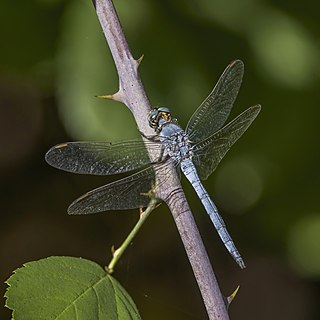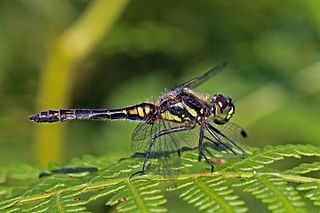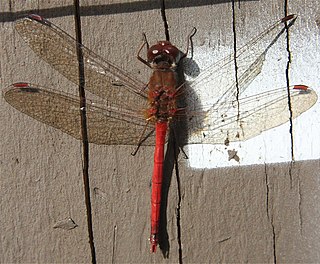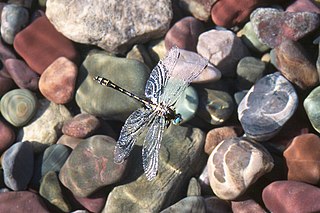
The black-tailed skimmer is a dragonfly belonging to the family Libellulidae.

The common whitetail or long-tailed skimmer is a common dragonfly across much of North America, with a striking and unusual appearance. The male's chunky white body, combined with the brownish-black bands on its otherwise translucent wings, give it a checkered look. Females have a brown body and a different pattern of wing spots, closely resembling that of female Libellula pulchella, the twelve-spotted skimmer. Whitetail females can be distinguished by their smaller size, shorter bodies, and white zigzag abdominal stripes; the abdominal stripes of L. puchella are straight and yellow.

The keeled skimmer, Orthetrum coerulescens, is a species of dragonfly belonging to the family Libellulidae.

The Large red damselfly, Pyrrhosoma nymphula, is a species of damselflies belonging to the family Coenagrionidae.

The flame skimmer or firecracker skimmer is a common dragonfly of the family Libellulidae, native to western North America.

Sympetrum danae, the black darter or black meadowhawk is a dragonfly found in northern Europe, Asia, and North America. At about 30 mm (1.2 in) long, it is Britain's smallest resident dragonfly. It is a very active late summer insect typical of heathland and moorland bog pools.

The ebony jewelwing is a species of broad-winged damselfly. One of about 150 species of Calopterygidae, it is found in the eastern U.S. and southeastern Canada, ranging west to the Great Plains. Other common names include black-winged damselfly.

Sympetrum vicinum, the yellow-legged meadowhawk or autumn meadowhawk, is a member of the Libellulidae family and grows to 26–35 mm long.

The tule bluet is a species of damselfly in the family Coenagrionidae found in North America, from northern Mexico to southern Canada.

The band-winged meadowhawk is a dragonfly of the genus Sympetrum belonging to the family Libellulidae.

Eastern forktail is a member of the damselfly family Coenagrionidae.

The marsh bluet is a damselfly species in the family Coenagrionidae.

The shadow darner is a species of dragonfly in the family Aeshnidae. It is found in almost all of Canada and most states in the United States.

The desert whitetail is a species of dragonfly in the family Libellulidae. P. subornata is often put into the genus Libellula.

Sympetrum madidum, the red-veined meadowhawk, is a species of dragonfly in the family Libellulidae.

The boreal bluet is a species of damselfly in the family Coenagrionidae.

Progomphus borealis is a species of dragonfly in the family Gomphidae. This dragonfly species is commonly known as the gray sanddragon.

Gomphurus externus, the plains clubtail, is a species of dragonfly in the family Gomphidae.

Phanogomphus graslinellus is a species of dragonfly in the family Gomphidae. This species is commonly known as the pronghorn clubtail.

The Hudsonian whiteface is a species of dragonfly in the family Libellulidae. Its common name comes from where it is found, Hudson Bay.





















